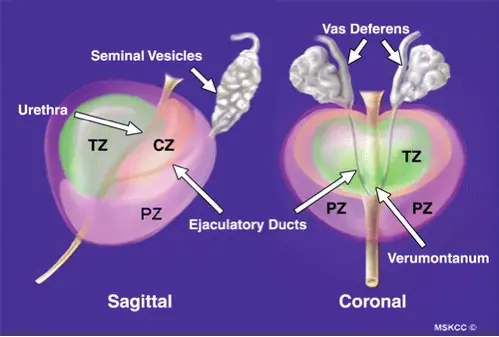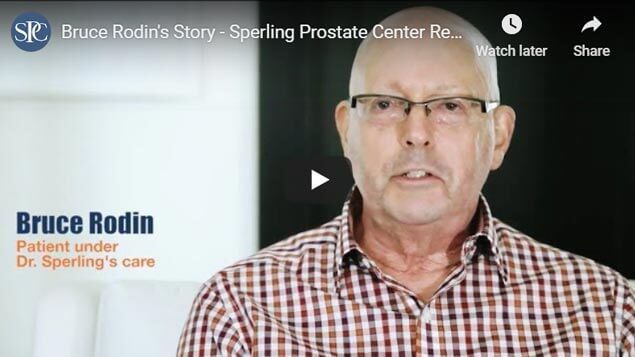Focal Laser Ablation for Benign Prostatic Hyperplasia (BPH)
What is Benign Prostatic Hyperplasia?
Benign Prostatic Hyperplasia is a normal non-cancerous enlargement of the prostate gland that occurs as men age. The types of tissue that make up the three prostate zones gradually change. The risk of BPH increases as a man grows older. Roughly 20% of men in their fifties experience BPH; 60% of men in their sixties have it, and by age ninety it affects 90% of men.
BPH Problems
Many patients are able to reduce symptoms through changes in behavior (e.g. reduced fluids before bedtime, dietary changes to exclude bladder irritants). Also, many supplements carry claims of easing symptoms, but research shows contradictory results; most studies conclude there is no significant benefit. As symptoms increase, patients may turn to prescription medications that can reduce symptoms. While this is now the most common BPH treatment, long term side effects are still being studied.
If drugs are not effective, surgical procedures to widen the urethra will be recommended. Such procedures are called transurethral, meaning instruments are inserted through the penis into the urethra (tube that carries urine out of the bladder) where it passes through the prostate gland, in order to physically widen the urethra. Examples are TURP, TUMT, TUNA, and transurethral laser delivery systems. See Frequently Asked Questions at the end for more details.
Because most of these interventions basically damage the lining of the urethra, healing can take up to several weeks. Side effect risks vary with each procedure.
The Sperling Solution
Dr. Dan Sperling, a leading expert in target ablation of prostate tumors, is the world’s leading pioneer in applying Focal Laser Ablation to treat Benign Prostatic Hyperplasia.
The Sperling Prostate Center offers a unique new FDA-cleared approach to treating BPH. With the same kind of MRI-guided Focal Laser Ablation (FLA) used to treat prostate cancer tumors, Dr. Dan Sperling has developed a patient-friendly outpatient treatment that relieves BPH in a single treatment with minimal side effects. After FLA, as the ablated tissue shrinks, pressure on the urethra passage is reduced naturally.
Identifying and targeting BPH
Before treatment, BlueLaser™ 3T mpMRI is used to produce a very high resolution, 3-D prostate scan of the three prostate zones to identify the TZ tissue areas to be ablated, and plan the best approach to the target.
A special case: enlarged median lobe of the prostate
In most BPH cases the tissue enlargement is somewhat uniform throughout the gland. However, there is another type of BPH that affects only a small, cone-shaped section of the gland called the median lobe, near the bladder neck. When BPH causes selective overgrowth of the median lobe, it can indent or squeeze the bladder neck, creating a mechanical blockage to urine flow.
An important point about median lobe BPH is that it is unlikely to respond to medication. Nor may such patients be candidates for conventional transurethral procedures. Focal laser ablation is an intervention that “unblocks” the interfering tissue by focusing on it precisely, giving maximum effect with minimal discomfort, short healing time, and few short term side effects.
Treating BPH with Focal Laser Ablation
Once the gland has been mapped out and the treatment path is planned, Focal Laser Ablation for BPH (FLA-BPH) relieves BPH-related urinary symptoms by reducing the enlarged TZ (transition zone) tissue causing urinary blockage. This process is called debulking because it diminishes the bulky BPH tissue. The ablation is done with the type of laser that coagulates, not vaporizes, tissue. By ablating targeted areas of the transitional zone near but not touching the urethra, FLA-BPH creates strategic tissue shrinkage by generating harmless scar tissue that will be reabsorbed by the body. There are minimal-to-no residual urinary or sexual side effects because the treated areas are contained well within the prostate gland away from other healthy tissues and structures. (Based on the location and extent of FLA, some patients may wear a catheter for several days to protect the urethra as inflammation diminishes.) The urinary symptoms of BPH begin to diminish within a few weeks as the resulting scar tissue is reabsorbed by the body.
FLA-BPH side effects
There are little-to-no long term side effects from FLA-BPH (as there can be with intraurethral ablation procedures) because in most cases we are not damaging the urethral lining. Erectile function is spared because the TZ is within the prostate and not adjacent to the nerves that control erection. Finally, the side effect called retrograde ejaculation (semen flowing backward into the bladder) that can occur after TURP or Green Light laser is much less likely after FLA-BPH. NOTE: As with transurethral procedures, minimal transient (short term) side effects may occur after FLA-BPH, but these tend to resolve quickly.
Advantages of FLA-BPH
- Outpatient procedure
- No general or spinal anesthesia, only local numbing
- Real-time guidance using our BlueLaser™ 3T mpMRI
- Nothing inserted into the penis or urethra
- The only focal treatment for median lobe BPH at the bladder neck
- One-time treatment with excellent results
- Little-to-no residual side effects
- Can accommodate larger gland sizes effectively
Frequently Asked Questions
▾ How is BPH diagnosed?
- Urinalysis
- Blood test, including PSA, free PSA or PSA density
- Urinary flow test
- Post-void residual volume test (any urine left in the bladder after urination)
- Urodynamic studies (water introduced into the bladder through a catheter to measure internal pressure and bladder contractions)
- Cystoscopy (insertion of a thin scope for visual inspection of the urethra and bladder)
- Imaging using a contrast dye to reveal aspects of the urinary system
▾ How is Focal Laser Ablation for BPH (FLA-BPH) different from transurethral procedures?
▾ Some of the other procedures also use laser. Are there different lasers?
▾ What is Transurethral Resection of the Prostate (TURP)?
▾ What is Transurethral Microwave Thermotherapy (TUMT)?
▾ What is Transurethral Needle Ablation (TUNA)?
▾ What is indigo laser therapy?
▾ What is laser vaporization therapy (Green Light Laser or KTP laser)?
▾ What is Rezum therapy?
▾ What is Urolift®?
End your BPH Struggle
We welcome the opportunity to answer your questions and help you craft a personalized path to wellness. Contact us today to schedule a free consultation and say goodbye to your BPH struggle.



